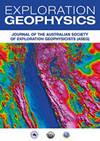层状地球中球体的电磁响应建模
IF 0.8
4区 地球科学
Q4 GEOCHEMISTRY & GEOPHYSICS
引用次数: 0
摘要
在目标距离源和接收器一定距离的情况下,通过地球物理电磁方法获取的数据建模和解释方面,估计层状地球中导电球体的电磁响应非常令人感兴趣。当使用机载电磁法(AEM)时,尤其是这种情况,其中源和接收器位于地下上方的某个高度。这个问题可以通过使用表示圆柱形函数导数的场展开来解决,圆柱形函数描述在层状地球中传播的场,而球形函数描述由球体反射的场。此外,这些表示允许发展圆柱形函数和球形函数之间的关系。这些函数和随后的关系已被用于开发一种算法,用于估计各向同性层状地球中导电球体的电磁响应。基于该算法的软件已经在合成数据和现场数据上进行了测试。所提供的现场数据是用加拿大安大略省Reid Mahafy试验场上空的AEM AirTEM系统收集的。这些测试的结果证明了AEM解释工具箱中分层地球模型中球体积分的重要性和实用性。本文章由计算机程序翻译,如有差异,请以英文原文为准。
Modelling the electromagnetic response of a sphere located in a layered earth
Estimating the electromagnetic response of a conductive sphere in a layered earth is of great interest in terms of both modelling and interpretating data acquired via geophysical electromagnetic methods where the target is at some distance from the source and receiver. This is particularly the case when using Airborne Electromagnetic Method (AEM) where the source and receiver are located at some height above the subsurface. This problem can be solved by utilising field expansions representing derivatives of cylindrical functions, which describe the fields propagating in the layered earth, and spherical functions, which describe the fields reflected by the sphere. Furthermore, these representations allow the development of relationships between cylindrical and spherical functions. These functions and subsequent relationships have been used to develop an algorithm for estimating the electromagnetic response of a conductive sphere in an isotropic layered earth. Software based on this algorithm has been tested on both synthetic and field data. The field data presented were collected with the AEM AirTEM system over the Reid-Mahaffy test site, Ontario, Canada. Results from these tests prove the importance and utility of integrating the sphere in a layered earth model in the AEM interpretation toolbox.
求助全文
通过发布文献求助,成功后即可免费获取论文全文。
去求助
来源期刊

Exploration Geophysics
地学-地球化学与地球物理
CiteScore
2.30
自引率
0.00%
发文量
33
审稿时长
>12 weeks
期刊介绍:
Exploration Geophysics is published on behalf of the Australian Society of Exploration Geophysicists (ASEG), Society of Exploration Geophysics of Japan (SEGJ), and Korean Society of Earth and Exploration Geophysicists (KSEG).
The journal presents significant case histories, advances in data interpretation, and theoretical developments resulting from original research in exploration and applied geophysics. Papers that may have implications for field practice in Australia, even if they report work from other continents, will be welcome. ´Exploration and applied geophysics´ will be interpreted broadly by the editors, so that geotechnical and environmental studies are by no means precluded.
Papers are expected to be of a high standard. Exploration Geophysics uses an international pool of reviewers drawn from industry and academic authorities as selected by the editorial panel.
The journal provides a common meeting ground for geophysicists active in either field studies or basic research.
 求助内容:
求助内容: 应助结果提醒方式:
应助结果提醒方式:


